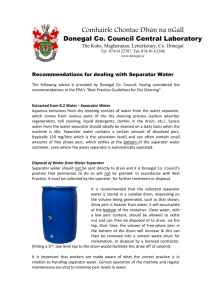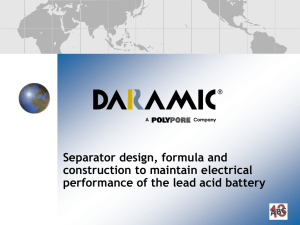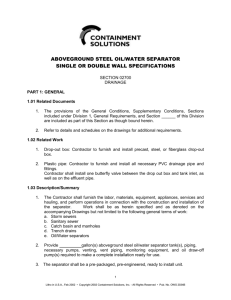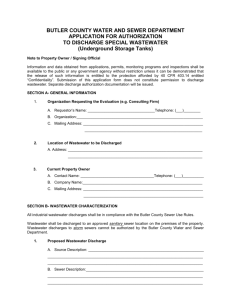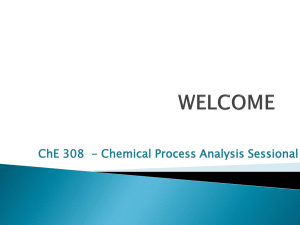treatment/disposal options - Florida Department of Environmental
advertisement
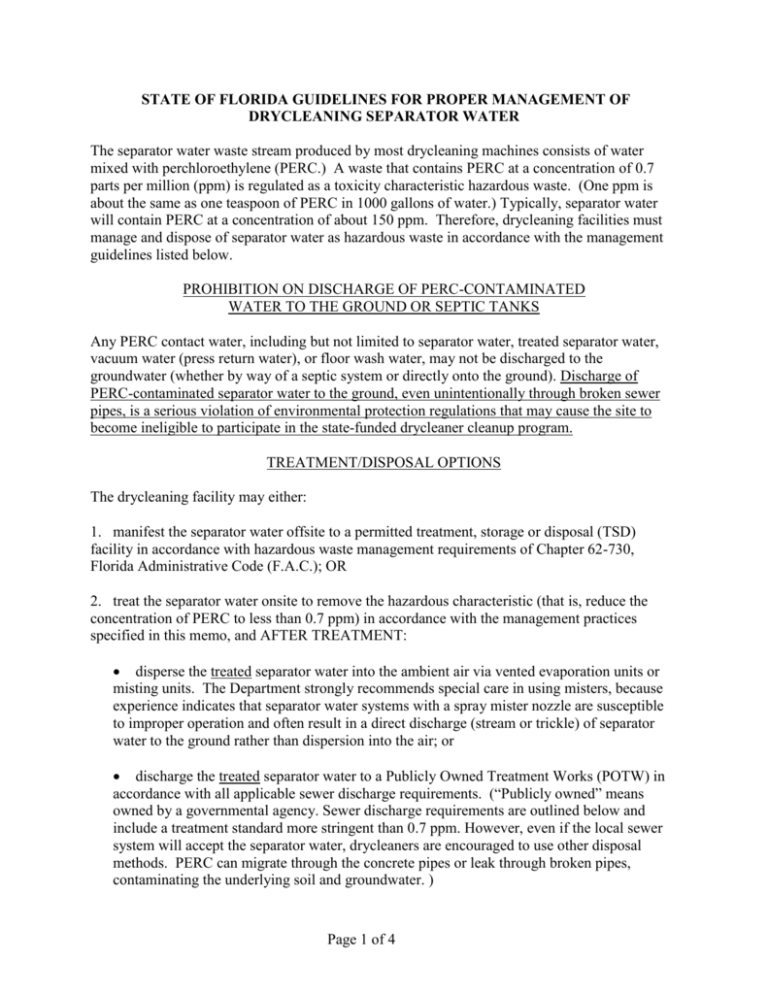
STATE OF FLORIDA GUIDELINES FOR PROPER MANAGEMENT OF DRYCLEANING SEPARATOR WATER The separator water waste stream produced by most drycleaning machines consists of water mixed with perchloroethylene (PERC.) A waste that contains PERC at a concentration of 0.7 parts per million (ppm) is regulated as a toxicity characteristic hazardous waste. (One ppm is about the same as one teaspoon of PERC in 1000 gallons of water.) Typically, separator water will contain PERC at a concentration of about 150 ppm. Therefore, drycleaning facilities must manage and dispose of separator water as hazardous waste in accordance with the management guidelines listed below. PROHIBITION ON DISCHARGE OF PERC-CONTAMINATED WATER TO THE GROUND OR SEPTIC TANKS Any PERC contact water, including but not limited to separator water, treated separator water, vacuum water (press return water), or floor wash water, may not be discharged to the groundwater (whether by way of a septic system or directly onto the ground). Discharge of PERC-contaminated separator water to the ground, even unintentionally through broken sewer pipes, is a serious violation of environmental protection regulations that may cause the site to become ineligible to participate in the state-funded drycleaner cleanup program. TREATMENT/DISPOSAL OPTIONS The drycleaning facility may either: 1. manifest the separator water offsite to a permitted treatment, storage or disposal (TSD) facility in accordance with hazardous waste management requirements of Chapter 62-730, Florida Administrative Code (F.A.C.); OR 2. treat the separator water onsite to remove the hazardous characteristic (that is, reduce the concentration of PERC to less than 0.7 ppm) in accordance with the management practices specified in this memo, and AFTER TREATMENT: disperse the treated separator water into the ambient air via vented evaporation units or misting units. The Department strongly recommends special care in using misters, because experience indicates that separator water systems with a spray mister nozzle are susceptible to improper operation and often result in a direct discharge (stream or trickle) of separator water to the ground rather than dispersion into the air; or discharge the treated separator water to a Publicly Owned Treatment Works (POTW) in accordance with all applicable sewer discharge requirements. (“Publicly owned” means owned by a governmental agency. Sewer discharge requirements are outlined below and include a treatment standard more stringent than 0.7 ppm. However, even if the local sewer system will accept the separator water, drycleaners are encouraged to use other disposal methods. PERC can migrate through the concrete pipes or leak through broken pipes, contaminating the underlying soil and groundwater. ) Page 1 of 4 SEWER DISCHARGE REQUIREMENTS Most publicly-owned utilities have local discharge standards that regulate what can be discharged to collection systems. The utilities must be notified and/or a permit must be obtained, prior to discharge, to ensure that the wastewater will comply with any local requirements. A copy of the notification to the POTW and permit, if required, must be maintained onsite. If there are no local requirements that are more stringent, then 0.53 ppm is the maximum concentration of PERC that can be discharged to a sewer system. Discharges that exceed that limit are considered a violation of Rule 62-625.400(2)(g), F.A.C. BEST MANAGEMENT PRACTICES FOR THE TREATMENT OF SEPARATOR WATER ONSITE Drycleaning facilities may use an onsite system to treat and subsequently disperse or discharge separator water to a sewer system as long as the system meets the following criteria. Any treatment system must be able to bring the PERC concentration of the separator wastewater below the hazardous waste toxic characteristic concentration of 0.7 ppm prior to dispersion to the ambient air, or below 0.53 ppm (or the more stringent local requirement) prior to discharge to the sewer system. Unless the drycleaner has analytical results on a treated sample to demonstrate the effectiveness of the treatment system, the drycleaner must have documentation from the treatment system manufacturer that demonstrates that under the drycleaner’s actual operating conditions the system is capable of reducing separator water PERC concentrations to less than 0.7 ppm for air dispersion or 0.53 ppm (or local requirement) for sewer discharge. Carbon filters, located in treatment units, must be changed routinely in accordance with manufacturer specifications. If filters are not changed regularly, waste waters pass through the treatment system untreated and become highly contaminated with PERC. The drycleaning facility must follow the treatment unit operation instructions and maintenance schedule recommended by the manufacturer; document the maintenance performed including dates of filter changes; and keep the records onsite for a three-year period. (The maintenance records may be retained with the files required under the general air permit). Proper operation of treatment units is essential for compliance with hazardous waste regulations. The treatment system and the air dispersion unit (evaporator, mister, or functionally equivalent unit) must remain closed except when adding wastewater. “Closed” means entirely connected with pipes or a comparable enclosed method that will minimize emissions prior to treatment. The air dispersion unit must be vented to the outside ambient air. Using crock-pots or pans heated over hot plates to evaporate separator water is prohibited. Page 2 of 4 The Department recommends that separator water treatment systems be hard-piped to the drycleaning unit to eliminate unnecessary handling of hazardous waste and reduce the potential for spills. Separator water that is hard-piped through a fully-functioning treatment system that reduces PERC concentrations to below 0.7 ppm is not counted toward the hazardous waste generation status of drycleaning facilities. If the drycleaning unit is not hard-piped to the treatment unit, the untreated separator water must be accumulated in a closed container (drum, bucket) and transferred to the treatment unit. The closed container must be labeled with the words “Hazardous Waste,” “Perchloroethylene Separator Wastewater,” or other words that clearly identify the contents as hazardous wastewater. The volume of hazardous wastewater stored in this way must be counted toward the drycleaner’s hazardous waste generator status. If the separator water treatment system is not hard-piped directly to the air dispersion unit, the separator water should be accumulated in a closed container and transferred to the air dispersion unit. The closed container should be labeled with the words “Treated Separator Wastewater,” or other words that clearly identify the contents. Secondary containment requirements apply to all containers of separator water (including treated separator water) and all components of any separator water treatment system. All spent absorption media filters (normally activated carbon) must be disposed of as a hazardous waste unless the filter media is regenerated onsite and reused. Although not required, a separator water treatment unit works best with A solvent/wastewater separation chamber prior to the PERC adsorption filter for additional recovery of PERC (or free solvent) not dissolved in the wastewater. A sensor to detect PERC breakthrough following the first carbon filtration unit. ADDITIONAL CONSIDERATIONS Facilities using 2100 gallons or less/year (1800 gallons or less/year for facilities with transfer machines) of PERC must be entitled to operate under the Title V Air General Permit Program. Facilities using more than 2100 gallons/year (more than 1800 gallons for facilities with transfer machines) of PERC must be entitled to operate under a major source Title V Air Permit. Solvent-contaminated wastewater from spotting boards should be managed as separator water. The Department recommends that vacuum water be managed as separator water, unless the vacuum water contains rust. Rusty water consumes the treatment filter and frequently disables the unit. The Department recommends that rusty vacuum water be managed as hazardous waste and manifested offsite to a permitted treatment, storage or disposal facility. Mop water containing soap/detergent and contaminated with PERC or any other chlorinated solvent should not be processed through a carbon adsorption unit since the unit will not operate Page 3 of 4 properly if soap/detergent is present. The Department recommends that mop water containing PERC and soap/detergent be managed as hazardous waste and manifested offsite to a permitted treatment, storage or disposal (TSD) facility. Mop water that does not contain PERC may be discharged to the POTW. No PERC-contaminated waste or materials should be discarded in a solid waste dumpster. Page 4 of 4

